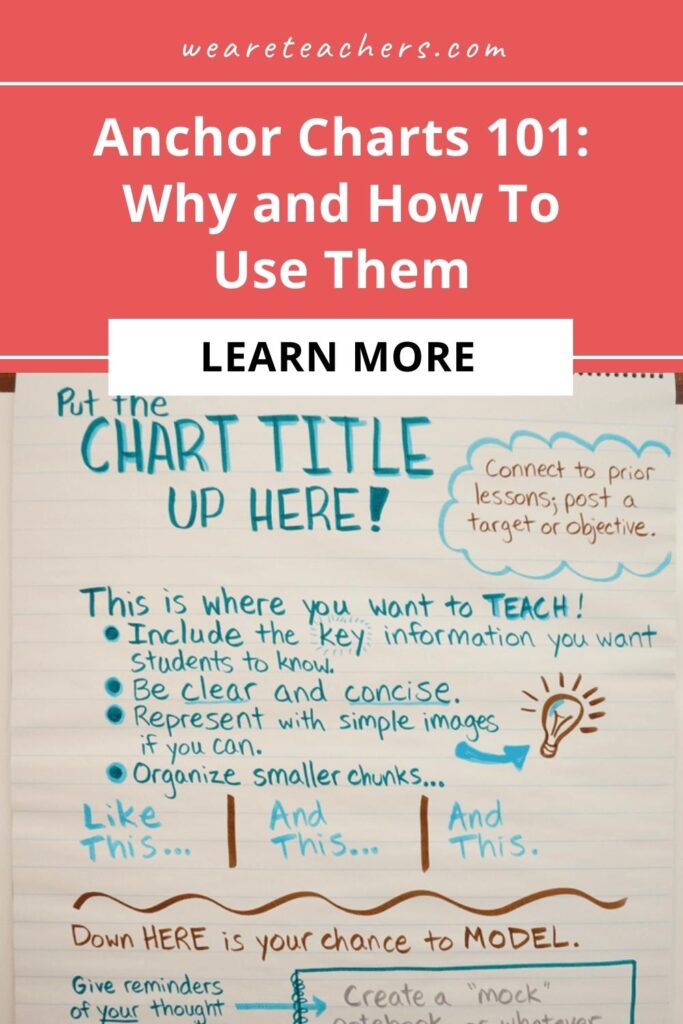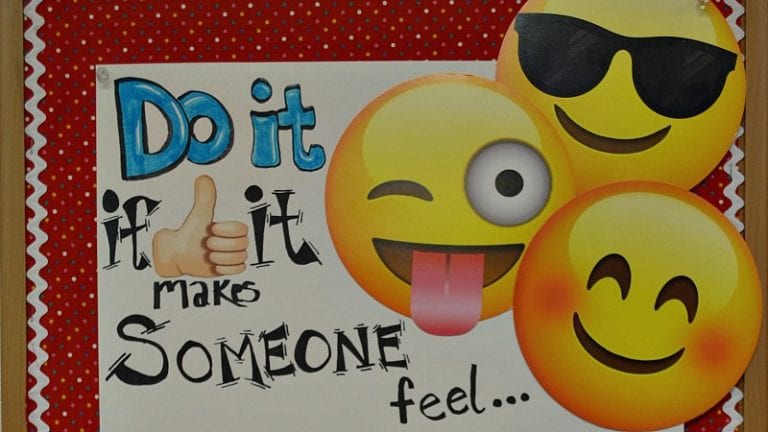One of the best, most effective tools for the classroom is anchor charts, although you won’t find Anchor Charts 101 on most teacher training programs’ syllabi. If you’re new to teaching, you may have lots of questions about what anchor charts are, what purpose they serve, how to get started, and when to use them. So we’ve created this primer to help you out! Also included is a huge list of anchor chart roundups to use as a resource. Once you get started, we’re pretty sure anchor charts are going to be one of your favorite go-to strategies.
What is an anchor chart?

Michelle Krzmarzick/Character Traits via krzmarzickm.blogspot.com
An anchor chart is a tool used to support instruction (i.e., “anchor” the learning for students). As you teach a lesson, you create a chart, together with your students, that captures the most important content and relevant strategies. Anchor charts build a culture of literacy in the classroom by making thinking—both the teacher’s and students’—visible.
How do I create anchor charts?
You really don’t need any special materials or artistic skills—just chart paper and a colorful assortment of markers.
It’s easy to incorporate anchor charts into your lesson plans. All it takes is a clear purpose and some pre-planning.
Typically, you will prepare the framework of your chart ahead of time, giving it a title, including the learning objective, and creating headers for the main points or strategies you want to highlight. It’s very important not to create the entire poster ahead of time. They are best used as an interactive tool with students.
As you model a lesson or learning strategy and interact with your students through discussion, you fill in the blank spaces of the anchor chart. For an awesome tutorial, check out this blog and template from third grade teacher Michael Friermood.

The Thinker Builder/Anchor Chart via thethinkerbuilder.com
After your chart is created, it can be displayed as needed—for a short unit, as a one-time reference tool, as something you continue to add to, or as something that stays up all year—like your classroom procedures or behavior expectations.
Posting the charts keeps relevant and current learning accessible to students, reminds them of prior learning, and enables them to make connections as new learning happens. Students can refer to them and use them as they think about the topic, question ideas, expand ideas, and/or contribute to discussions in class.
A few helpful tips:
Make them colorful and print-rich.
Use different colors and bullet points to help students discriminate between strategies and quickly access information.
Keep them simple and neat.
Use easy-to-read graphics and clear organization. Don’t allow distracting, irrelevant details or stray marks, such as arrows or overemphatic use of underlining.
Draw simple pictures to complement the words.
The more ways students can access information about a subject, the better.
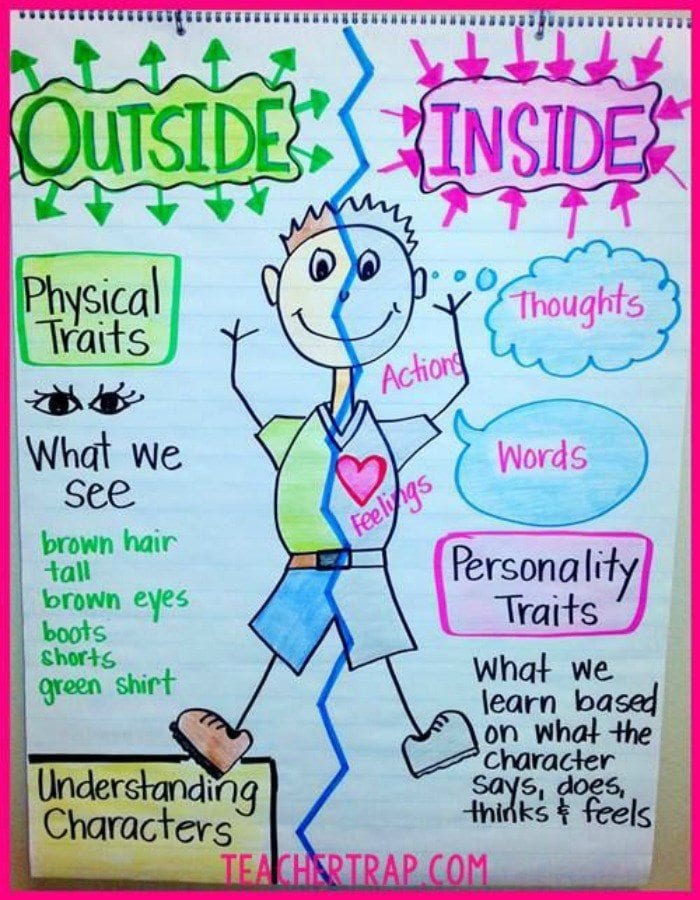
Teacher Trap/3 Secrets for Teaching Character Traits via teachertrap.com
Don’t overuse them.
While anchor charts are a super-useful tool, don’t feel as if you need to create one for every single lesson. Choose carefully so the ones you create have the greatest impact.
Don’t be afraid to borrow from others.
Teachers always get their best ideas from other teachers. If your teammate has already tackled a topic, use the same format. Just make sure you create your own version from scratch so your students experience the learning as you go. You’ll find tons of examples at the links included below.
How do I use anchor charts in my classroom?
Now that you know the how, you may be wondering about the when and why. Here are a few ways to get the most bang for your buck.
Reach maximum engagement.
When students are involved in the process of creating learning tools, they are more likely to comprehend more deeply and remember more of what they learn. Anchor charts trigger connections with the initial lesson.
Bring lessons to life.
If you are studying a topic that lends itself particularly well to a visual aid, create an anchor chart! If you are studying plants, draw a giant flower and label all of the parts of it while you teach about it.

2nd Grade Ponderings/Anchor Chart Linky Party via 2ndgradeponderings.blogspot.com
Support independent work.
Anchor charts provide students with a source to reference when working on their own. They support students and also save teachers from having to spend classroom time going over concepts multiple times.
Create a library of reference materials.
To help students keep information straight, you could create charts for each topic. For example, if you’re teaching math concepts, you could create a chart for geometric shapes, the difference between perimeter and area, and how to multiply and divide fractions.
Reinforce classroom procedures.
Provide students with a visual to remind them of routines that make your classroom run smoothly. Some examples: how to use centers, how to line up, how to check books out of your classroom library.
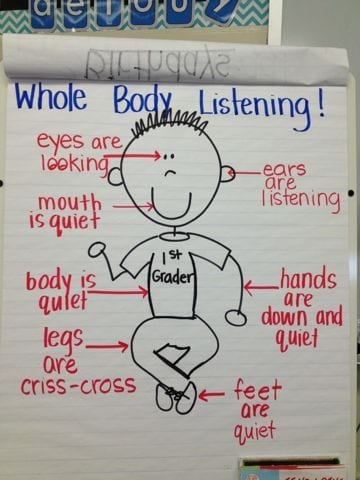
The Primary Buzz/Learning to listen via theprimarybuzz.blogspot.com
Try them in shared writing.
Model how to write an introduction, the parts of a letter, and the proper use of grammar such as quotation marks, commas, etc.
Use them as a companion to read-alouds.
Create an anchor chart as you stop to make observations, ask questions, take note of story elements, or make predictions.
How can I use anchor charts to introduce new skills?
Anchor charts are great for laying the foundation for a new unit of study and giving an overview of concepts. They make it easy to break complex concepts down into bite-size pieces. If you are teaching U.S. government, for example, create a diagram of the three branches of government along with the primary responsibilities of each, to help simplify the concept for students.
The charts are also great for helping students keep track of vocabulary. For each chart, include a box with vocabulary words as an easy reference for students.
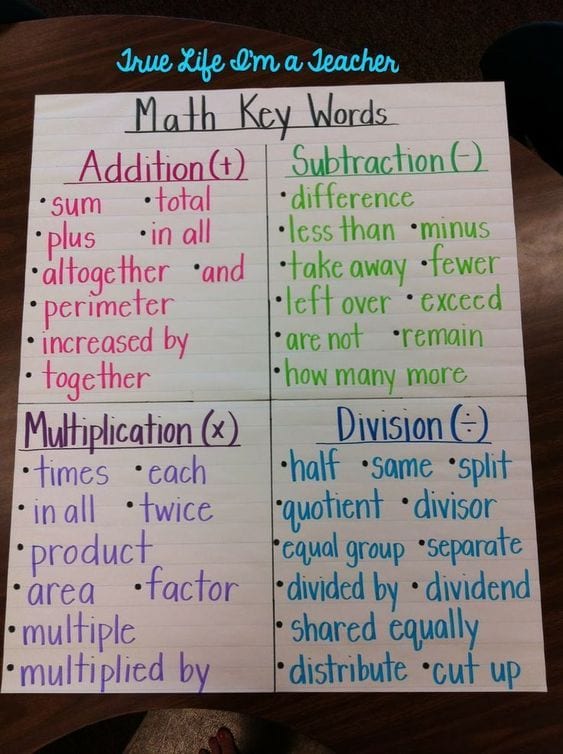
True Life I’m a Teacher/Anchor Charts via truelifeimateacher.com
Helpful Links and Resources
Now that you’ve got the basics of Anchor Chart 101, it’s time to get inspired! Here are links to the best chart compilation articles on WeAreTeachers:
- 20 Anchor Charts To Help Boost Kids’ Tech Skills, Virtually or in the Classroom
- 15 Anchor Charts To Teach Main Idea
- 12 Character Traits Anchor Charts for Elementary and Middle School ELA Classes
- 18 Fraction Anchor Charts for Your Classroom
- 15 Anchor Charts for Teaching Theme
- 49 Anchor Charts That Nail Reading Comprehension
- 15 Fantastic Sustainability and Recycling Anchor Charts
- 17 Anchor Charts To Teach Place Value
- 19 Classroom Management Anchor Charts
- 40 Must-Have Anchor Charts for Teaching Writing of All Kinds
- 17 Fabulous Fluency Anchor Charts
- 23 Close Reading Anchor Charts That Will Help Your Students Dig Deep
- 12 Anchor Charts To Help Teach Financial Literacy to Your Students
- Get Your Facts Straight With These 18 Nonfiction Anchor Charts
- 20 Perfect Anchor Charts To Teach Phonics and Blends
In addition, there are over 1,000 examples of anchor charts on our WeAreTeachers Pinterest boards. Search by subject matter on topics from math and science to reading and writing to classroom management or by grade level.
Do you 😍 anchor charts as much as we do? Come and share your best tips in our WeAreTeachers HELPLINE group on Facebook.
Plus, check out 10 Awesome Ideas for Anchor Chart Organization and Storage.
